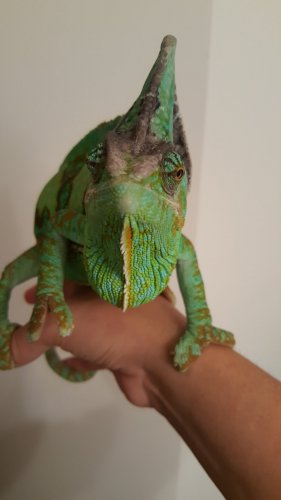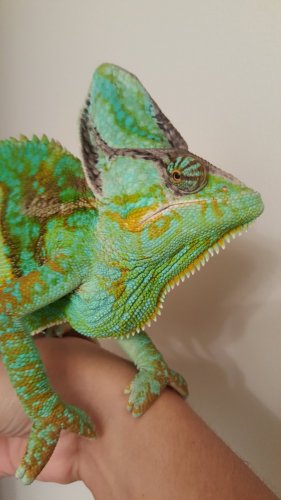BuddhaBud
Established Member
Chameleon Info:
Cage Info:
Current Problem - The current problem you are concerned about. We've recently noticed Buddha seems to have an enlarged lower gular area.. In doing some quick research stumbled upon "Gular Edemas" which looked similar to what Buddha's got going on. I've heard anything from heart failure (?!?!?!) to over-supplementation could cause an edema. Has anyone seem this before?? Should we take him to the vet?! Despite his throat, his behavior hasn't changed, he's still eating, pooping & drinking normally. My fiance & I would really appreciate another opinion... Please see pix:


- Your Chameleon - The species, sex, and age of your chameleon. How long has it been in your care? Veiled Chameleon named Buddha, male, 1 year & about 2 months old (born 1/4/17) - we adopted him June 6th, 2017 so just shy of 8 months.
- Handling - How often do you handle your chameleon? Daily. He's very tame & non aggressive.
- Feeding - What are you feeding your cham? What amount? What is the schedule? How are you gut-loading your feeders? His diet consists of a combination of goliath hornworms, silkworms, dubia's & an organic spring salad mix. Depending on what we have available, he'll eat either 1-2 large hornworms / day OR 3-4 medium silk/hornworms / day OR 1 large dubia / day, fed in the morning. We offer greens in the afternoon, or he munches on his umbrella tree. He's really not a fan of dubia's, though he does consume them occasionally. The hormworms are gut loaded with Repashy Superhorn, silkworms with mulberry silkworm feed, dubia's with organic greens & Fluker's orange cubes. We've been out of silkworms since the holidays.
- Supplements - What brand and type of calcium and vitamin products are you dusting your feeders with and what is the schedule? Rep-Cal Calcium (no phosphorus, no vit. D3) - daily. Repti Calcium (with vit. D3) - once monthly, week one. Rep-Cal Herptivite Multivitamins - once monthly, week three.
- Watering - What kind of watering technique do you use? How often and how long to you mist? Do you see your chameleon drinking? We mist his cage 3-4 times daily, for about 1 minute long increments, using a pressurized pump mister. There's a fogger directed down through the top of the cage that also provides a steady drip onto his vines. We learned early our veiled was unique - not only would he snatch water droplets out of the air, he would also drink from a dish. Therefore, we have two small ramekin's we refill & wash daily with ambient temp filtered water - he drinks them down everyday & we often see him striking the water for a drink or two.
- Fecal Description - Briefly note colors and consistency from recent droppings. Has this chameleon ever been tested for parasites? His droppings are brown & white with clear urate. He's very regular, pooping in the morning around 8-9AM daily. Never been tested.
- History - Any previous information about your cham that might be useful to others when trying to help you. We adopted him from a local family run petstore with great reviews. They knew the breeder & the lil' guy was in great shape when we took him home. We did a lot of research prior to adopting him but there's always more to learn.. When Buddha was upgraded from his juvenile cage (18"x18"x36") to his adult enclosure (2'x2'x4'), we had some issues develop from him climbing all over the screens - he ended up losing about half his toe-nails, poor guy. One of his feet began to show signs of infection so we immediately took him to see a Herpetologist who prescribed an oral antibiotic. The treatment was successful & he's been slowly regrowing his nails since.
Cage Info:
- Cage Type - Describe your cage (Glass, Screen, Combo?) What are the dimensions? Buddha's room is a 2'x2'x4' ReptiBreeze screen mesh cage. The inside is retrofitted with 1x1 cm weather treated garden fencing on all surfaces but the door - so he grips the fencing, not the screens. The cage is about 2' off the ground within a shelving unit.
- Lighting - What brand, model, and types of lighting are you using? What is your daily lighting schedule? 24" Reptisun Terrarium hood w/ T5 HO UBV linear bulb, 75w Repti Tuff splashproof halogen basking lamp & 50w Repti Tuff splashproof halogen basking lamp (dimmed down). On at 7:30AM off at 7:30PM.
- Temperature - What temp range have you created (cage floor to basking spot)? Lowest overnight temp? How do you measure these temps? His basking spot's (top fourth of the cage) range from 85-90 degrees F. The lower three fourths of his cage range from 80 to 70 degrees F. Lowest overnight temps are 65-70 degrees F. We take precise measurements with a heat gun & measure the room temp with a Galileo Thermometer.
- Humidity - What are your humidity levels? How are you creating and maintaining these levels? What do you use to measure humidity? Daily his humidity ranges from 40-60%. We use a fogger pointed in his cage from above (on when he's awake only) & we have large humidifier in the same room as his cage (perpetual). We mist is cage 3-4 times daily with a pressurized pump mister. A MistKing is in the near future. We have hygrometer inside the enclosure.
- Plants - Are you using live plants? If so, what kind? Not in his cage, no. We use fake plants / vines within his cage & he has an umbrella tree to free range in.
- Placement - Where is your cage located? Is it near any fans, air vents, or high traffic areas? At what height is the top of the cage relative to your room floor? The cage is about 2' off the ground , within a shelving unit. We have 9' ceilings & the top of the cage is about 2.5' from it. There are no windows, fans, or vents near the cage nor in his room. The cage is also upstairs in a "loft" area, where it naturally stays a little warmer. There is a skylight in his room.
- Location - Where are you geographically located? Minneapolis, MN
Current Problem - The current problem you are concerned about. We've recently noticed Buddha seems to have an enlarged lower gular area.. In doing some quick research stumbled upon "Gular Edemas" which looked similar to what Buddha's got going on. I've heard anything from heart failure (?!?!?!) to over-supplementation could cause an edema. Has anyone seem this before?? Should we take him to the vet?! Despite his throat, his behavior hasn't changed, he's still eating, pooping & drinking normally. My fiance & I would really appreciate another opinion... Please see pix:






